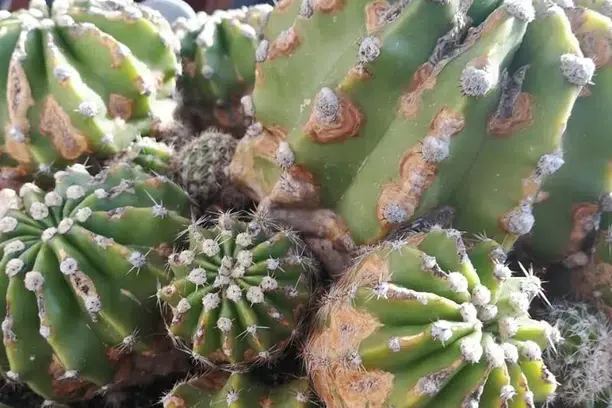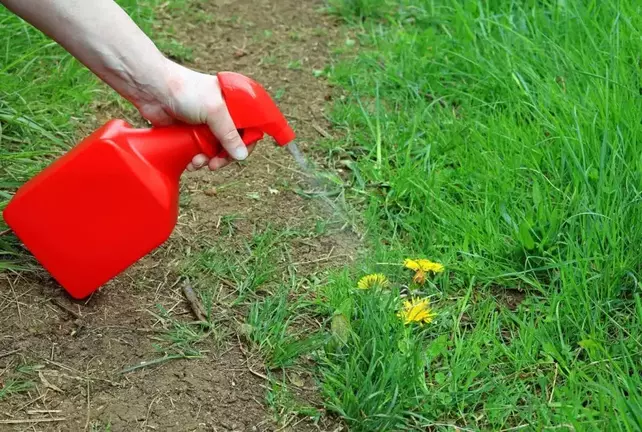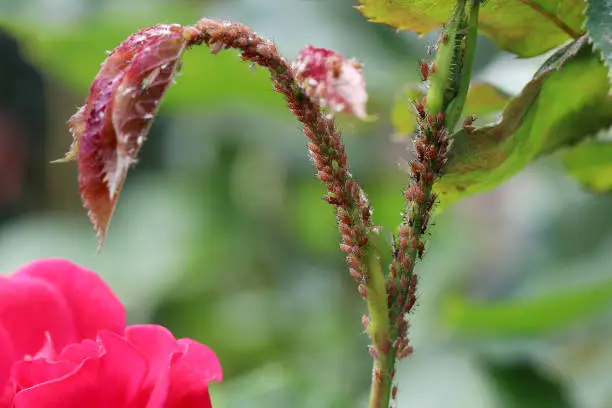Pothos (Epipremnum aureum) is a vining plant commonly grown in baskets and produces beautiful heart-shaped leaves. It is also called golden pothos or devil’s ivy. Philodendron (Philodendron Selloum), too, is a vining houseplant with variously shaped leaves. These two plants seem a lot similar, but there are differences between pothos and philodendrons.
Pothos leaves are heart-shaped while philodendron leaves are lobe-shaped, sometimes with fenestrations. Another difference is that philodendrons have a cataphyll sheath while pothos leaves simply unfurl from the original leaf.
Pothos have grooved petioles and one aerial root per node while philodendrons have a round petiole with several roots per node on the vines.
Pothos and philodendrons are two of the most common, easy-to-grow indoor plants that are often confused for one another. Although they do share some similarities, they have distinct characteristics.
Pothos vs Philodendron – The differences
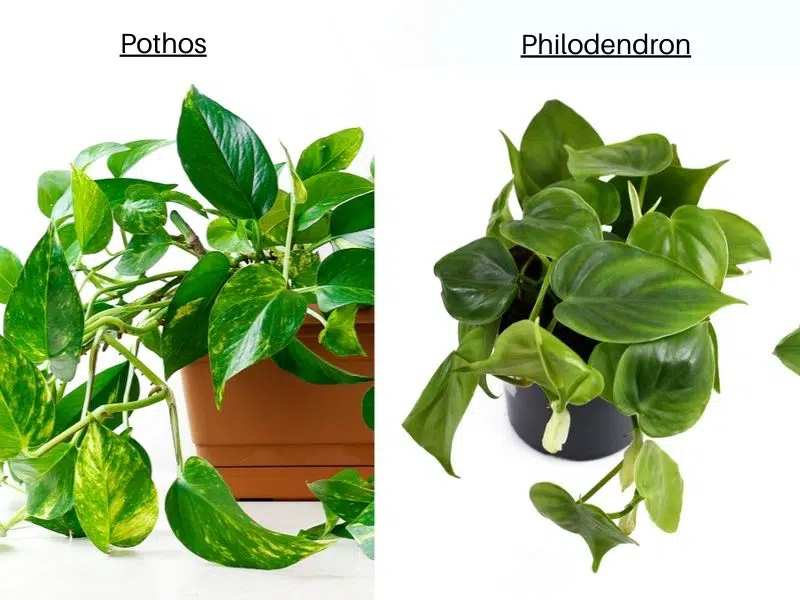
There are key differences between pothos and philodendrons that can help distinguish them. The two houseplants have different growth patterns as well as a few physical features that you can use to tell them apart.
To tell the difference between philodendrons and pothos, pay attention to leaf shape and texture, how new leaves are formed, petioles, and aerial roots.
Here are the major differences:
| Pothos | Philodendron |
| Pothos has thick leaves that are heart-shaped with golden, white, or yellow variegation. | Philodendron leaves are lobe-shaped and are more or less pinnate. |
| Pothos leaves have a rough or bumpy texture with a waxy feel to them. | Philodendron leaves are glossy with a smooth texture compared to pothos. |
| Pothos climbs using one large aerial root per node. | Philodendrons are also spread by climbing but with several aerial roots per node. |
| Pothos petioles are grooved. The groove runs between the leaf and the plant’s stem. | Philodendron petioles are usually round, smooth, and typically slender compared to those of pothos. |
| Golden Pothos’ prefers medium light, too bright indirect sunlight for brighter variegation. | Philodendrons prefer medium light but can tolerate low light even for prolonged periods. |
| Stipules are not free on pothos. | Philodendron stipules are free. |
RELATED: WHAT IS INDIRECT LIGHT FOR PLANTS
Apart from these differences, there are many similarities in the growing requirements such as light and water needs between pothos and philodendron plants.
Here are the differences in detail:
Leaf shape
Pothos leaves are pointed and heart-shaped, sometimes variegated with white, gold, yellow, or pale green variegation while philodendron leaves are large and imposing, usually lobbed in shape with deep natural cuts; and can be pinnate or not.
Cataphyll
A cataphyll is a reduced, small leaf. This type of leaf is usually modified in a way to perform some specialized functions. You can tell the difference between pothos vs philodendrons by checking for cataphylls.
Philodendrons have cataphylls from which leaves emerge. These leaf-like structures perform photosynthesis before turning brown, drying, and falling off. On the other hand, pothos plants don’t have cataphylls. Leaves grow and extend on their own to perform photosynthesis.
See the image below:
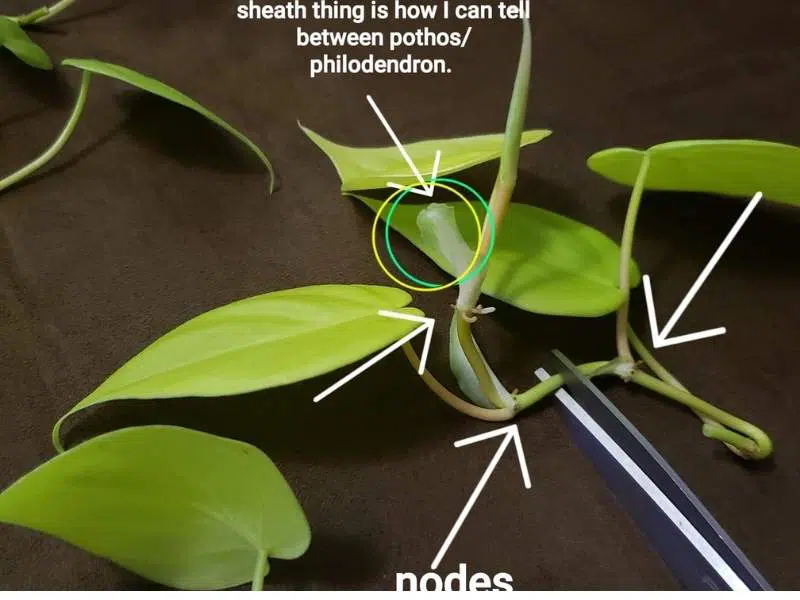
There are two types of cataphylls in philodendrons:
- Deciduous cataphyll: This type “curls away from the leaf once it has formed, eventually turning brown and drying out, and finally falling off the plant, leaving a scar on the stem where it was attached.” It is common in vining philodendrons.
- Persistent cataphyll: This type does not fall off even after drying up. It remains at the node and can form a fibrous tissue where it is attached to philodendrons.
Leaf texture
To tell difference, feel the leaf texture of the two plants. If it’s smooth and glossy, it is a philodendron, but if it’s matte, it is pothos. However, some pothos varieties such as golden pothos have a smooth leaf texture (as you will see in the video below) just like philodendrons.
When you try to feel the texture, you’ll find that the philodendron leaf is smoother than that of the pothos because the top side is even and has a velvety feel. On the other hand, the top side of the pothos leaf is slightly raised and has a well-defined ridge down the center midrib.
Aerial roots
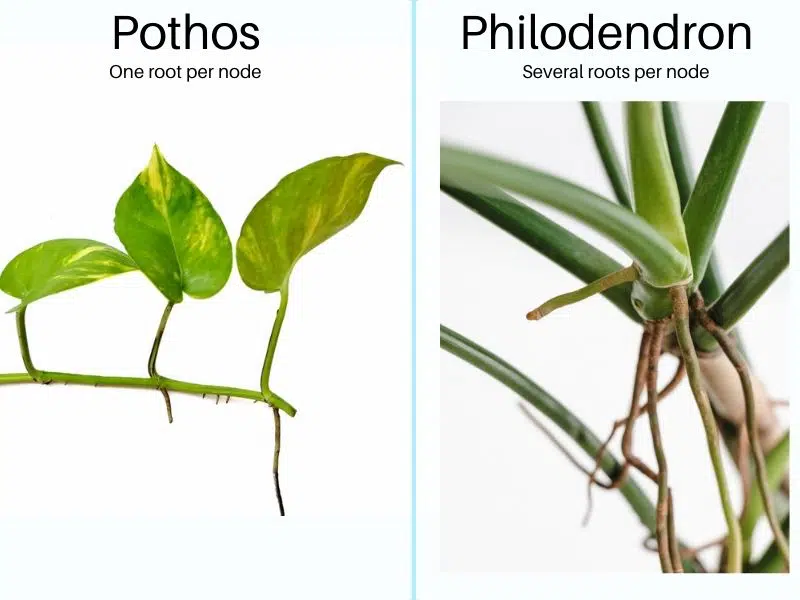
Both pothos and philodendrons are climbing plants but the difference between them is that pothos grows one large root per node while philodendrons develop numerous climbing roots per node.
These roots grow out of the vines right at the nodes (the swollen, knuckle-like parts of the stem from which leaves emerge) and the plants use them to attach to surrounding trees or objects for support as they creep up.
Petioles
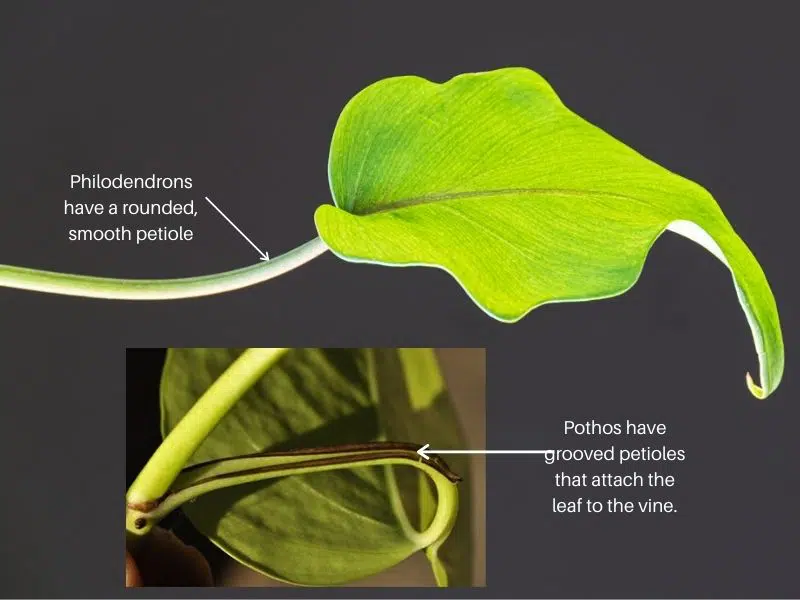
Another clear difference between philodendron and pothos can be seen in the petioles. A petiole is a small stalk that provides support to the leaf and attaches it to the main stem of the plant.
Pothos’ petioles are grooved and textured while philodendron’s petioles are round and smooth. In pothos, the petioles may have a dark coloration on the inside that can make the groove invisible. You can identify this difference by feeling along the petiole of pothos and philodendron plants.
Stipules
A stipule is a small leaf-like appendage to a leaf, typically growing in pairs at the base of the leaf stalk.
Pothos’ stipules are fused to the stem and petiole while philodendron stipules are free. Stipules in pothos can grow up to about 38 cm long and appear to be papery in texture, enclosing the petiole until the leaf expands fully.
Light needs
The pothos prefers bright, indirect light for them to grow and develop properly. This is the opposite of what the philodendron prefers as this plant can only thrive in areas with low light intensity. The philodendron also holds its variegation better in areas with low light.
The pothos plant does not tolerate direct sunlight, but it can take up more intensity than the philodendrons without getting sunburned.
Water retention and growth rate
The pothos can retain water for longer periods than the philodendron. This is all thanks to its thick leaves. That is why a pothos plant is considered to be more drought-resistant as compared to the philodendron.
It could also be the reason why when put in the same setting and provided with the same conditions, pothos grows at a faster rate than a philodendron.
RELATED: WHAT ARE THE SIGNS OF ROOT ROT ON POTHOS
Pothos identification and profile
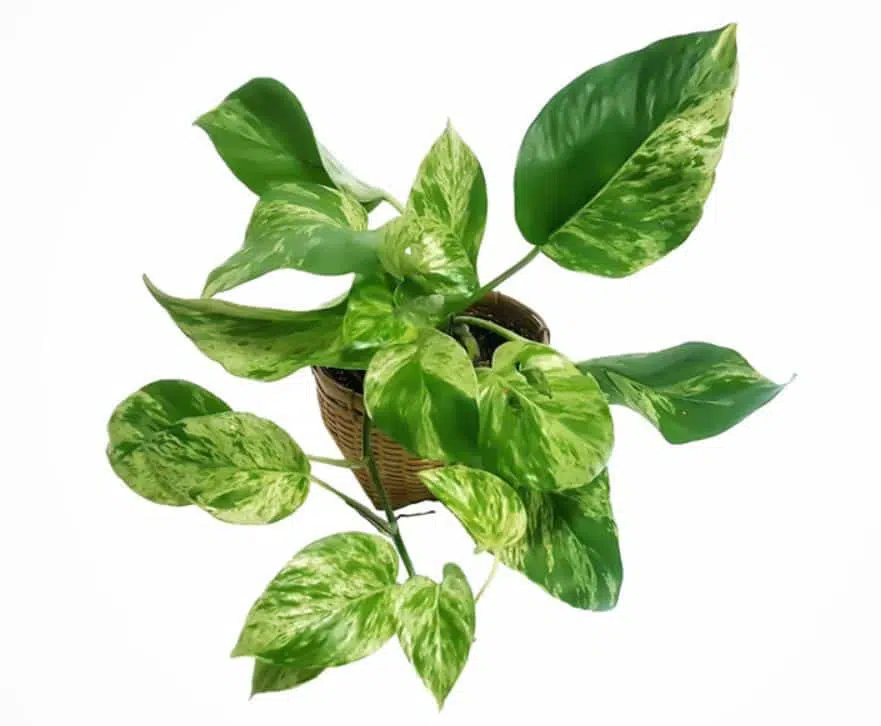
Pothos is a type of flowering plant in the Araceae family. It is native to Moorea, a location in the Society Islands of French Polynesia. You may also hear people refer to this plant as the Devil’s Ivy, the Devil’s vine, or Epipremnum aureum (its scientific name).
- The leaves of Epipremnum are usually 3-4 inches long and they’re distinctly heart-shaped with a chordate base.
- Leaves are often variegated with green and gold variegation.
- The petioles are canaliculate – they have a groove in them.
Unfortunately, often that groove is outlined by a darker color. There are two examples of those grooves in the petiole. They don’t always have that dark color outlining the grooves. Sometimes you just have to feel it to know that it’s there but a lot of times it is there.
Golden pothos grows as a ground cover and as a ground cover it gets to 6-8 inches tall. However, it can also climb like a vine and if allowed to do so can climb up to 40 feet tall.
Note: Some cultivars of golden pothos have completely gold leaves while others may just have green leaves, but typically the most common kind found in cultivation are these green leaves with the golden variegation.
- Leaf shape: The leaves of pothos are irregularly shaped and have short ends.
- Roots: Pothos have limited aerial roots that emerge as small, thick nubs. Normally you will find one root per node.
- Flowers: Pothos can produce yellow, green, or even purple flowers.
- Length: Pothos can grow to a maximum length of 3 feet.
Common types of pothos
There are several types of pothos plants, and each of these types differs in one way or another from the philodendron species.
To help you understand this clearly, let us look at some common pothos plants and the ways in which they differ from the philodendron.
Golden pothos
Golden pothos is a species of the pothos family. It is usually loved by many because of its light lime-colored leaves that have some yellow variegation. With this, the plant is known to brighten up any corner it is placed in.
So how does the golden pothos differ from the philodendron?
Golden Pothos vs. Heartleaf philodendron
The leaves of the golden pothos are larger than those of the heartleaf philodendron. In essence, the golden pothos’ leaves can grow up to 30 inches in length. On the other hand, the leaves of the philodendron can grow to a maximum of 12 inches in length.
A golden pothos plant rarely produces flowers when indoors, but when it does, the flowers are either green or purple in color. The heartleaf philodendron, on the other hand, usually produces white or yellowish-white flowers.
Jade Pothos
Jade pothos is a common indoor plant in many homes as it is very easy to look after. Just like all the other pothos species, its stem can grow to up to 3ft. One of its notable features is its vines, which are known to cascade elegantly when placed in a hanging basket.
Jade Pothos vs. Neon Philodendron
The leaves of the jade pothos are dark green in color, while those of the neon philodendron are brightly yellowish in color.
Brasil Pothos
The Brasil pothos is another popular type of plant in the pothos family.
Brasil pothos vs. Cordatum
The leaves of the cordatum are fully green while those of the brasil pothos are green but have a yellow-like line in the middle.
Water requirements
Just like any other houseplant, proper watering of a pothos plant is vital in ensuring that it flourishes. So how should you water a pothos plant?
- Ensure that you keep the soil moist by watering the entire round ball, but be careful not to overwater.
- Pothos do well in soil that is allowed to dry out between watering. To achieve this, you need to allow the top two inches to dry while being sure that the soil is still moist.
- Try using distilled water or rainwater. If you cannot get access to either of those, use filtered water.
Light requirements
Even though the pothos plant can grow in a wide variety of light conditions, including low light, it is advisable that you place it in an area with moderate indoor light.
Here is why moderate light is ideal;
- In very low light, the plant may lose its variegation.
- If the pothos plant is placed in an area with “high-light” conditions, pothos species with pale green leaves will turn yellow.
Note: If you wish to place it outside, put it under a shade in a place where there is no direct sunlight.
Soil type and pH
Soil Type: The pothos plant is not always fussy when it comes to the type of soil they are planted in. That is why you can plant it in any ordinary potting soil as long as it is well-draining.
Soil pH: Pothos plants do well in soils that have a pH that ranges from 6.1 to 6.5.
Some people like adding fertilizers to the soil in which they plant the pothos, and there is no problem in doing so. In fact, this is a great decision if you wish to see your plant thrive as most potting soils do not have nutrients that the fertilizers can provide. If you do decide to use fertilizers on the pothos’ soil, make sure you apply them once or twice a month.
Pothos care tips
Here are a few tips that will help you take care of your pothos plant.
- Grow your pothos indoors. Just as mentioned earlier, pothos like bright but not indirect light. Ensure that the area you set it up at, meets these criteria.
- Grow the pothos in a hanging container or in a container that rests on a bookshelf. This allows its superior cascading habitat to be appreciated.
- Although the pothos plant usually has no serious disease or pest issues, it is good to check on it regularly just to be sure and safe. If you find pests on it, take a cotton ball dipped in alcohol and use it to kill the pests.
- Sometimes you may find that the pothos’ roots have consumed the pots. If this happens, make sure you repot it.
When doing this, make sure the next pot you use is at least one size larger than the previous one. Also, use fresh potting soil and discard the soil that was in the previous pot.
Philodendron pictures and identification
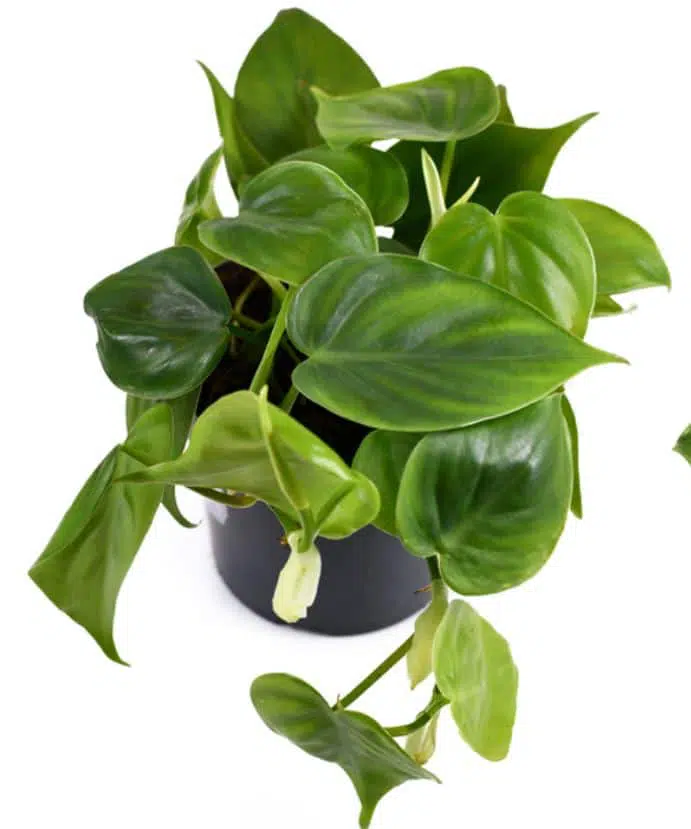
Philodendron, on the other hand, Philodendron Selloum, belongs to the Araceae family and is a flowering plant just like the pothos. The philodendron species can be found in many regions around the West Indies region and in the tropical Americas.
The traditional philodendron that everybody’s grandmother had in the house had solid green leaves. It’s a vine but more recently there’s been a lot more breeding work on philodendrons and now we have several new cultivars on the market.
Anything from yellow stripe variegation in the center of the leaf to lemon-lime leaves that are very striking has become a really popular color today. The other one that’s even more unique perhaps is the Swiss cheese philodendron that has a solid green leaf but with holes in it.
Here are the major identifying features of philodendrons:
- Glossy, heart-shaped leaves.
- Non-grooved petioles
- Free stipules where new foliage is forming
- The shape of Leaves: The leaves of philodendrons are rounded and heart-shaped. They also have a long spout-like tip.
- Roots: Philodendrons have extensive roots.
- Flowers: Philodendrons produce green flowers all year round.
- Length: Philodendrons can grow to a maximum length of 5-6 feet.
Water requirements
Philodendrons do well when water is provided in moderation. Basically, you should not overwater or underwater the plant.
Also, always let the top inch of the soil dry up before commencing the next watering session.
Note: When your philodendron leaves start turning yellow, know that you have been overwatering them. If the leaves appear wilted or start turning brown, this is a sign that the plant has been under-watered. If you make the necessary changes to your watering schedules and techniques with respect to these signs, the philodendron will go back to normal.
Light requirements
Philodendrons grow best in low indirect sunlight. This is because that is the type of lighting they get in the tropical canopy (their natural habitat).
- The plant can tolerate low light, but its stems become leggy if it is placed in an area that has very little to no little light at all. When you see this, move it to a slightly brighter area.
- When the plant is getting too much sun than what it can tolerate, most of its leaves turn yellow. When this happens, move the plant to a darker area.
Soil type and pH
Soil type: For the best results, fill the philodendron plant’s pot with equal parts of sand soil, loam and peat.
Soil pH: The pH of the soil should be between 5.0 and 6.0.
Philodendron care tips
- Feed the philodendron plant with a fertilizer that has a lot of macronutrients. Macronutrients are essential in the growth and development of philodendron because without them; you will find that the plant will start producing pale leaves. This is usually a sign that it lacks magnesium and calcium, which are vital macronutrients.
- Use a pebble tray of water to maintain humidity around philodendron plants. You should also mist them every two days during the growing season.
- Some varieties of philodendron grow extremely fast, especially the climbers. For this reason, it is important to keep the plant manageable by pinching off the new growth. You are also supposed to repot the plant once every year as they are known to outgrow their pots.
- Just like the pothos, philodendrons are not prone to insects. However, there are instances where you may find some mealybugs and aphids on them. When this happens, use a cotton ball dipped in alcohol to wipe them off.
- Apply insecticidal soap on philodendrons regularly to keep insects/pests at bay.
Can you plant pothos and philodendron together?
One of the most popular questions that usually come up when dealing with pothos and philodendron is whether these two amazing houseplants can be planted together.
The answer is yes. It is possible for one to plant pothos and philodendrons together. This is because they have many similar requirements. As long as you give each of these plants adequate space, and tend to their needs properly, everything will be fine.
There is no doubt that pothos and philodendron are spectacular house plants that can add spice and flavor to any living space’s design. As much as pothos and philodendrons share some similarities, they are two different plants.
For instance, the pothos plant loves bright light while the philodendrons love slow light areas. All in all, if you take care of each of them properly, as indicated in this article, you will definitely enjoy having them around.
References + Resources:
[1] Amy Gibbs and Brian Hudelson, UW-Madison Plant Pathology: Pothos Plant Profile Guide
[2] North Carolina State University Extension: Epipremnum aureum (Devil’s IvyDevil’s VineGolden PothosIvy ArumMarble QueenPothosTaro Vine).
[3] Illinois University Extension: Philodendron or Pothos
